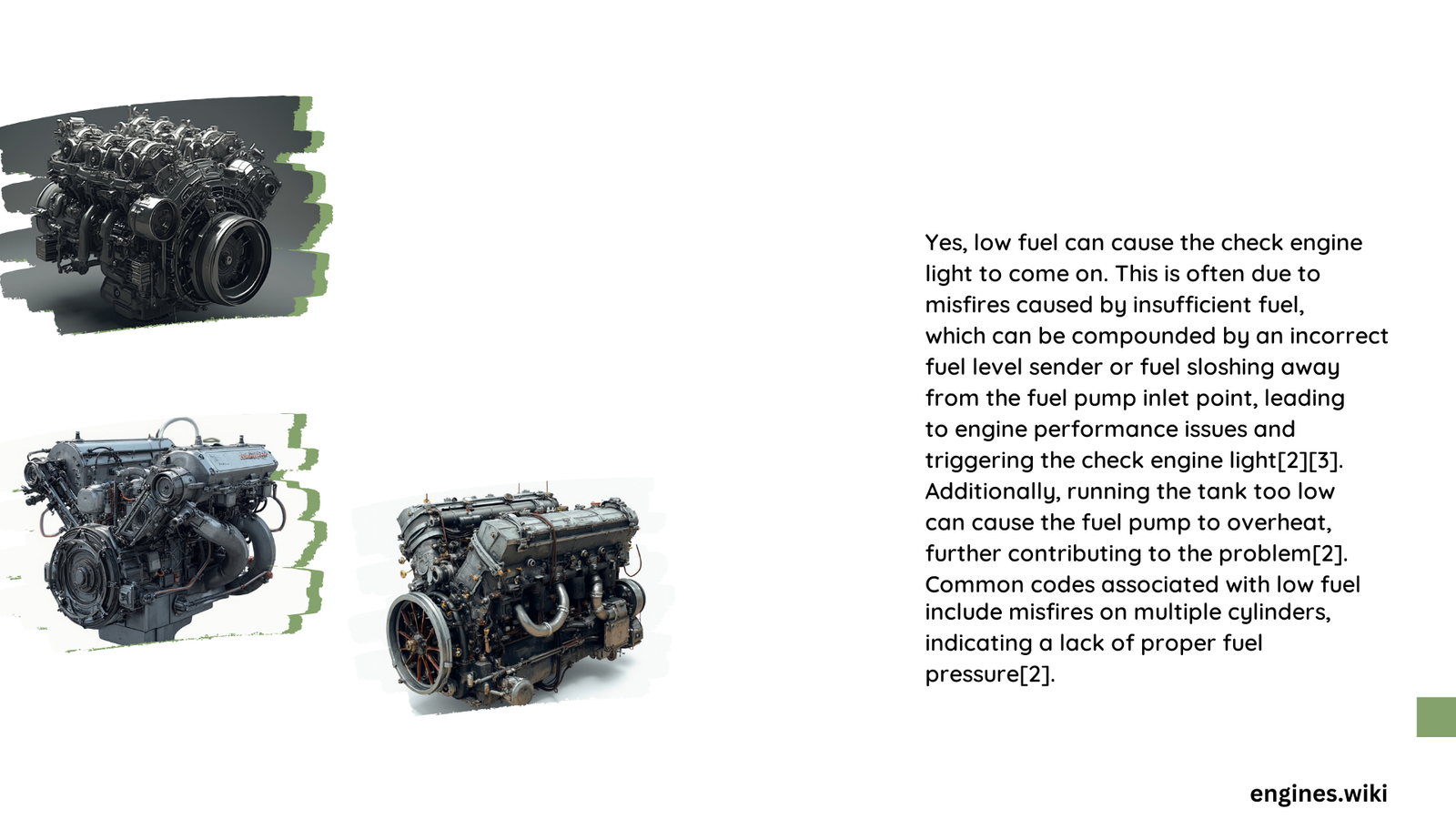Low fuel levels can indirectly trigger the check engine light in vehicles. While the fuel level itself doesn’t directly activate the warning, running on very low fuel or completely emptying the tank can lead to fuel system issues that may cause the check engine light to illuminate. This article explores the relationship between low fuel and the check engine light, including potential causes, diagnostic challenges, and associated costs.
What Are the Mechanisms Behind Low Fuel Triggering the Check Engine Light?
The check engine light is designed to alert drivers to potential issues with the vehicle’s engine or emissions system. While low fuel itself doesn’t directly trigger this warning, it can lead to conditions that activate the light:
-
Fuel System Malfunctions: Running out of gas can cause components like the fuel pump to overheat or become damaged, leading to issues detectable by the engine control module (ECM).
-
Fuel Pressure and Flow Problems: Low fuel levels can affect fuel pressure and flow, which are monitored by various sensors. Anomalies in these readings can trigger the check engine light.
-
Fuel Injector Issues: Extremely low fuel levels may lead to fuel injector problems, such as clogging or malfunctioning, which the ECM can detect and report.
Under What Specific Conditions Can Low Fuel Activate the Check Engine Light?

While there’s no specific fuel level threshold that directly triggers the check engine light, certain low-fuel-related conditions can lead to its activation:
- Fuel Pump Failure: Running out of gas can cause the fuel pump to overheat or fail, triggering the warning light.
- Fuel Injector Malfunctions: Low fuel levels can lead to fuel injector issues, which the ECM may detect and report.
- Fuel Sensor Problems: If fuel system sensors malfunction due to low fuel conditions, this can trigger the check engine light.
It’s important to note that these issues are more about the consequences of low fuel rather than the low fuel level itself.
Is There a Direct Correlation Between an Empty Gas Tank and Check Engine Light Activation?
An empty gas tank doesn’t directly trigger the check engine light based solely on the fuel level. However, the consequences of running out of gas can lead to conditions that activate the light:
-
Fuel System Diagnostic Trouble Codes (DTCs): Running out of gas can result in DTCs related to the fuel system, such as issues with the fuel pump, injectors, or pressure sensor.
-
No Specific Fuel Level Threshold: There isn’t a set fuel level that triggers the check engine light. Instead, it’s the resulting malfunctions or anomalies in the fuel system that trigger the warning.
What Are the Potential Challenges and Costs of Diagnosing Low Fuel-Related Check Engine Light Issues?
Diagnosing and resolving check engine light issues related to low fuel levels can involve several steps and costs:
- Diagnostic Scans:
- Cost: $20 to $100
-
Purpose: Identify specific trouble codes and determine the cause of the issue
-
Fuel System Repairs:
- Fuel Pump Replacement: $200 to $1,000
-
Fuel Injector Cleaning/Replacement: $50 to $500
-
Sensor Replacements:
- Cost varies depending on the specific sensor and vehicle model
- Generally quicker to replace than more complex components like fuel pumps
| Repair Type | Cost Range | Time to Repair |
|---|---|---|
| Diagnostic Scan | $20 – $100 | 30 minutes – 1 hour |
| Fuel Pump Replacement | $200 – $1,000 | 2 – 4 hours |
| Fuel Injector Service | $50 – $500 | 1 – 3 hours |
| Sensor Replacement | Varies | 30 minutes – 2 hours |
How Can Drivers Prevent Low Fuel-Related Check Engine Light Issues?
To avoid potential problems and costly repairs associated with low fuel levels, consider the following preventive measures:
- Maintain Adequate Fuel Levels: Try to keep your gas tank at least 1/4 full at all times.
- Regular Maintenance: Follow your vehicle’s recommended maintenance schedule to keep the fuel system in good condition.
- Address Warning Signs Promptly: If you notice any unusual behavior from your vehicle, especially related to fuel consumption or performance, have it checked by a professional.
- Use Quality Fuel: Stick to reputable gas stations and use the recommended fuel grade for your vehicle.
By following these guidelines, you can minimize the risk of low fuel-related issues triggering your check engine light and potentially save on repair costs in the long run.
What Should You Do If Your Check Engine Light Comes On After Running Low on Fuel?
If your check engine light illuminates after you’ve run very low on fuel or run out of gas completely, follow these steps:
- Refuel Immediately: Add fuel to your tank as soon as possible.
- Monitor the Light: Sometimes, the check engine light will turn off on its own after refueling and driving for a short distance.
- Check for Other Symptoms: Pay attention to any unusual noises, smells, or performance issues.
- Use an OBD-II Scanner: If you have access to one, scan for diagnostic trouble codes.
- Consult a Professional: If the light persists or you notice other issues, have your vehicle inspected by a qualified mechanic.
Remember, while low fuel can indirectly cause the check engine light to come on, it’s always best to address any warning lights promptly to prevent potential damage to your vehicle.
References:
1. Fox Run Auto: The 9 Most Common Causes for the Check Engine Light
2. CarAdvise: A Simple Guide to the Check Engine Light and Diagnostic Trouble Codes
3. GenVibe Forum: Ran out of gas. Now the engine light is on
